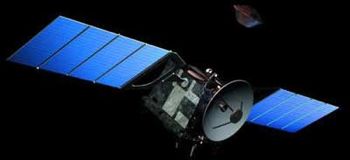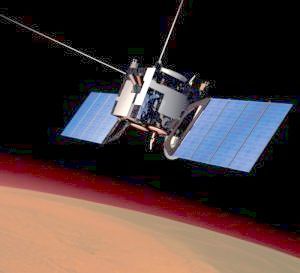Mars Express (original) (raw)

Home - Search - Browse - Alphabetic Index: 0- 1- 2- 3- 4- 5- 6- 7- 8- 9
A- B- C- D- E- F- G- H- I- J- K- L- M- N- O- P- Q- R- S- T- U- V- W- X- Y- Z
Mars Express
European Mars orbiter. The European Space Agency's Mars Express orbiter, designed to be built more quickly than any other comparable planetary mission, was a resounding success. Mars orbiter, Mars lander (Beagle 2) satellite built by Astrium for ESA, Europe. Launched 2003.
Status: Operational 2003. First Launch: 2003-06-02. Last Launch: 2003-06-02. Number: 1 . Gross mass: 1,042 kg (2,297 lb).
The Beagle 2 Mars lander was released from Mars Express on approach to the Red Planet, but did not return any data.
Prime contractor was Astrium, Toulouse, France, leading a consortium of 24 companies from 15 European countries and the United States. The Beagle lander was developed by the University of Leicester, UK. Launch mass of 1120 kg consisted of the 113 kg orbiter and 60 kg lander.
The Orbiter's instruments included:
- High Resolution Stereo Camera (HRSC), designed to image the entire surface of Mars at high resolution (10 meters/pixel) and selected areas at super resolution (2 meters/pixel)
- Energetic Neutral Atoms Analyzer (ASPERA), which ASPERA measured ions, electrons and energetic neutral atoms in the outer atmosphere, to reveal the numbers of oxygen and hydrogen atoms (the constituents of water) interacting with the solar wind and the regions of such interaction.
- Planetary Fourier Spectrometer (PFS), designed to determine the composition of the Martian atmosphere from the wavelengths of sunlight (in the range 1.2-45 microns) absorbed by molecules in the atmosphere and from the infrared radiation they emit. It measured the vertical pressure and temperature profile of carbon dioxide which made up 95% of the Martian atmosphere, and looked for minor constituents including water, carbon monoxide, methane and formaldehyde.
- Visible and Infra Red Mineralogical Mapping Spectrometer (OMEGA), designed to produce a map of the mineral composition of the surface at 100 meter resolution. It measured the visible and infrared light reflected from the planet's surface in the wavelength range 0.5-5.2 microns.
- Sub-Surface Sounding Radar Altimeter (MARSIS), designed to map the sub-surface structure to a depth of a few kilometers. The instrument's 40-metre long antenna sent low frequency radio waves towards the planet, which reflected from any surface they encounter.
- Mars Radio Science Experiment (MaRS), which used the radio signals that convey data and instructions between the spacecraft and Earth to probe the planet's ionosphere, atmosphere, surface and interior.
- Ultraviolet and Infrared Atmospheric Spectrometer (SPICAM), designed to determine the composition of the atmosphere from the wavelengths of light absorbed by the constituent gases. The ultraviolet (UV) sensor measured ozone, which absorbed 250-nanometre light, and the infrared (IR) sensor measured water vapor, which absorbed 1.38 micron light.
Spacecraft operations were conducted from the European Space Operations Centre (ESOC), Darmstadt, Germany, via the ESA ground station in New Norcia, near Perth, Australia. The spacecraft was designed for two Martian years of operation (3.7 earth years).
The Beagle 2 lander was planned to:
- determine the geology and the mineral and chemical composition of the landing site
- search for life signatures (exobiology)
- study the weather and climate
NASA NSSDC Master Catalog Description
Mars Express is a European Space Agency (ESA) mission to Mars. It consists of an orbiter, the Mars Express Orbiter, and a lander, Beagle 2. The scientific objectives of the Mars Express Orbiter are to obtain global high-resolution photo-geology (10 m resolution), mineralogical mapping (100 m resolution) and mapping of the atmospheric composition, study the subsurface structure, the global atmospheric circulation, and the interaction between the atmosphere and the subsurface, and the atmosphere and the interplanetary medium. The Beagle 2 lander objectives were to characterize the landing site geology, mineralogy, and geochemistry, the physical properties of the atmosphere and surface layers, collect data on martian meteorology and climatology, and search for possible signatures of life.
Spacecraft and Subsystems
The Mars Express Orbiter is a cube-shaped spacecraft with two solar panel wings extending from opposite sides. The launch mass of 1123 kg includes a main bus with a 113 kg of payload, the 60 kg lander, and 457 kg of propellant. The main body is 1.5 m x 1.8 m x 1.4 m in size, with an aluminum honeycomb strucure covered by an aluminum skin. The solar panels measure about 12 m tip-to-tip. A 1.8 m diameter high-gain antenna is mounted on one face, pointing in the same direction as the solar panels. Two 20 m long wire dipole antennas extend from opposite side faces perpendicular to the solar panels as part of the radar sounder. A 4 m tubular monopole low-gain antenna extends from the upper face. The body is built around the main propulsion system, which consists of a bi-propellant 400 N main engine. The two 267-liter propellant tanks have a total capacity of 595 kg. Approximately 370 kg are needed for the nominal mission. Pressurized helium from a 35 liter tank is used to force fuel into the engine. Trajectory corrections will be made using a set of eight 10 N thrusters, one attached to each corner of the spacecraft bus. Attitude control (3-axis stabilization) is achieved using two 3-axis inertial measurement units, a set of two star cameras and two Sun sensors, gyroscopes, accelerometers, and four 12-Nms reaction wheels. Pointing accuracy is .04 degrees with respect to the inertial reference frame and 0.8 degrees with respect to the Mars orbital frame. Thermal control is maintained through the use of radiators, multi-layer insulation, and actively controlled heaters. The spacecraft configuration is optimized for a Soyuz/Fregat, but is fully compatible with a Delta II launch vehicle if necessary.
Spacecraft power is provided by the solar panels which contain 11.42 square meters of silicon cells. The originally planned power was to be 660 W at 1.5 AU but a faulty connection has reduced the amount of power available by 30%, to about 460 W. This loss of power is not expected to significantly impact the science return of the mission. Power is stored in three lithium-ion batteries with a total capacity of 64.8 Ah for use during eclipses. The power is fully regulated at 28 V, the peak power requirement at Mars is 450 W. Telecommunications are via the high-gain parabolic antenna and two omnidirectional low-gain S-band antennas. These provide X-band (7.1 GHz) and S-band (2.1 GHz) uplink and downlink. Two Mars lander relay UHF antennas are mounted on the top face for communication with the Beagle 2. The spacecraft is run by two Control and Data management Units with a 10 gigabit solid state mass memory for storage of data and housekeeping information for transmission.
The science payload consists of seven experiments. The high resolution stereoscopic camera (HRSC) is mounted inside the spacecraft body, aimed through the top face of the spacecraft, which is nadir pointing during Mars operations. A visible and near-infrared spectrometer (OMEGA), infrared spectrometer (PFS) and ultraviolet spectrometer (SPICAM) are also mounted inside pointing out the top face. The neutral and charged particle sensors (ASPERA) are mounted on the top face. The subsurface radar and altimeter is mounted in the body and is nadir pointing, and also incorporates the two 20 m antennas. The radio science experiment (MaRS) uses the communications subsystem. The total mass budgeted for the science payload is 116 kg.
Beagle 2
The Beagle 2 is a lander initially mounted on the top deck of the Mars Express Orbiter. It was released from Mars Express on 19 December and reached Mars on 25 December. However no signals have been received from the lander and the mission was declared lost. For more information on the Beagle 2 lander, see:
http://nssdc.gsfc.nasa.gov/nmc/spacecraftDisplay.do?id=2003-022C
Mission profile
Launch took place on a Soyuz/Fregat from Baikonur Cosmodrome on 2 June 2003 at 23:45 local time (17:45 UT, 1:45 p.m. EDT), with the Mars Express and Fregat booster put into a 200 km Earth parking orbit. The Fregat was fired again at 19:14 UT to put the spacecraft into a Mars transfer orbit, and the Fregat and Mars Express separated at approximately 19:17 UT. The solar panels have been deployed and a trajectory correction maneuver will be performed on 4 June to aim Mars Express towards Mars and allow the Fregat booster to coast into interplanetary space. Mars Express arrived at Mars after a 400 million km journey and a course correction in September, in December 2003. The Beagle 2 lander was released on 19 December at 8:31 UTC (9:31 CET) on a ballistic cruise towards the surface. On 20 December, Mars Express fired a short thruster burst to put it into position to orbit the planet. The Mars Express Orbiter fired its main engine for 37 minutes on 25 December at 2:47 UT (9:47 p.m. EST, 24 December) and went into a highly elliptical 250 km x 150,000 km initial capture orbit with an inclination of 25 degrees. The orbit was adjusted by four more main engine firings starting on 30 December to the desired 258 km x 11,560 km near polar (86.3 degree inclination) orbit with a period of 7.5 hours. Near periapsis the top deck will be pointed down towards the martian surface and near apoapsis the high gain antenna will be pointed towards Earth for uplink and downlink. After 440 days the apoapsis was lowered to 10,107 km and periapsis raised to 298 km to give an orbital period of 6.7 hours. Aerobraking can be used to modify the orbit if there are any problems with the main engine. Nominal mission duration was planned to be 1 martian year (687 Earth days) but it was been extended multiple times. The orbit was changed in January 2009 to maintain illumination conditions. As of September 2015, the orbiter continues to operate.
The Beagle 2 coasted for five days after release and entered the martian atmosphere on the morning of 25 December. Landing was expected to occur at about 02:54 UT on 25 December (9:54 p.m. EST 24 December). No signals have been received and the lander was declared lost.
The overall Mars Express budget excluding the lander is 150 million Euros (roughly $150 million U.S.)
More at: Mars Express.
Family: Mars orbiter. Country: Europe. Engines: S400. Launch Vehicles: R-7, Mars tactical rocket, Soyuz-FG. Projects: Mars. Launch Sites: Baikonur, Baikonur LC31. Agency: ESA, EADS Astrium. Bibliography: 2, 3913, 3914, 3915, 6683, 12800.
Photo Gallery
 |
Mars ExpressView of Mar polar regions from Mars ExpressCredit: ESA |
|---|
 |
Mars Express (F-1) /Credit: Manufacturer Image |
|---|
2003 June 2 - . Launch Site: Baikonur. Launch Complex: Baikonur LC31. LV Family: R-7. Launch Vehicle: Soyuz-FG.
- Mars Express (F-1) / Mars Orbiter / Beagle 2 - . Mass: 1,120 kg (2,460 lb). Nation: Europe. Agency: ESA. Manufacturer: Friedrichshafen. Class: Mars. Type: Mars probe. Spacecraft: Mars Express. USAF Sat Cat: 27816 . COSPAR: 2003-022A. Apogee: 177 km (109 mi). Perigee: 177 km (109 mi). Inclination: 51.80 deg. Period: 88.00 min.
Europe's first probe to Mars. Mars Express had a mass of 637 kg dry, including science payload and Beagle separation device, together with 480 kg of propellant and the 69 kg Beagle 2 lander, for a total of 1186 kg. In addition to this a 37 kg adapter remained attached to the Fregat upper stage. Mars Express was placed into a 1.014 x 1.531 AU x 0.2 deg orbit around the Sun, following a course correction on June 5. The launch was first moved forward from June 1 and May 31 to May 23. Then delayed to June 6, then moved forward to June 2.
2003 December 19 - .
- Beagle 2 Separation From Mars Express, Successful - . Nation: UK. Spacecraft: Mars Express.
2003 December 25 - .
- Beagle 2 Lands On Mars - . Nation: UK. Spacecraft: Mars Express.
2003 December 25 - .
- Mars Express, Mars Orbit Insertion, Successful - . Nation: Europe. Spacecraft: Mars Express.
2004 January 28 - .
- Mars Express, Mapping Orbit Established - . Nation: Europe. Spacecraft: Mars Express.
2005 May 10 - .
- Mars Express, Deployment of MARSIS Instrument, first Boom, Successful - . Nation: Europe. Spacecraft: Mars Express.
2005 June 13 - .
- Mars Express, second Deployment of MARSIS Instrument, Successful - . Nation: Europe. Spacecraft: Mars Express.
Home - Search - Browse - Alphabetic Index: 0- 1- 2- 3- 4- 5- 6- 7- 8- 9
A- B- C- D- E- F- G- H- I- J- K- L- M- N- O- P- Q- R- S- T- U- V- W- X- Y- Z
© 1997-2019 Mark Wade - Contact
© / Conditions for Use
